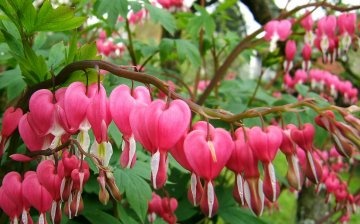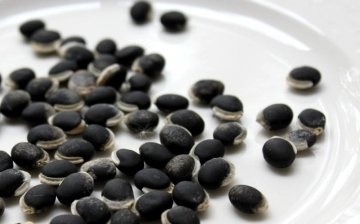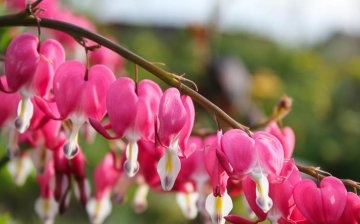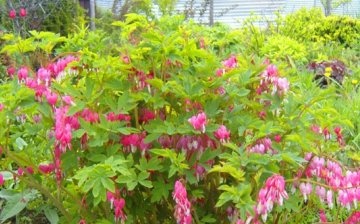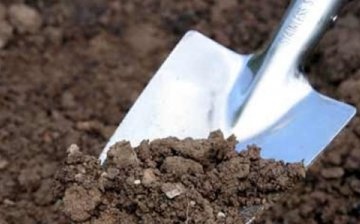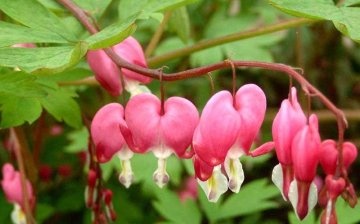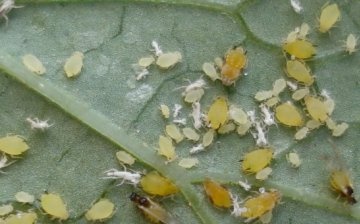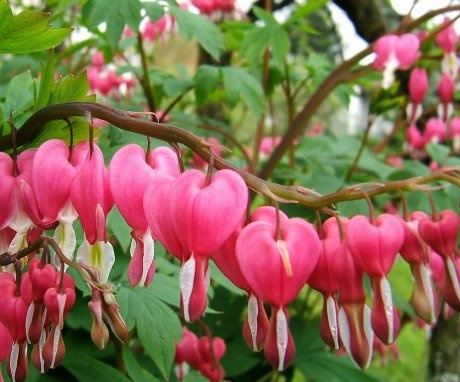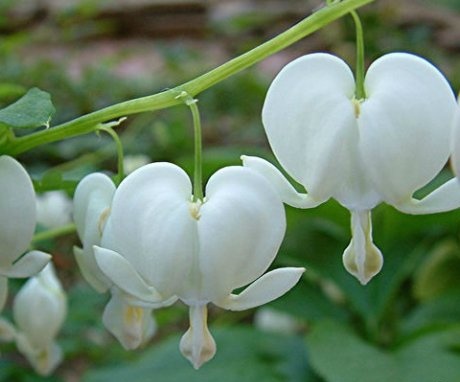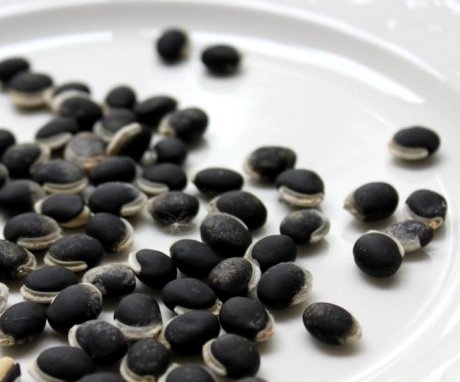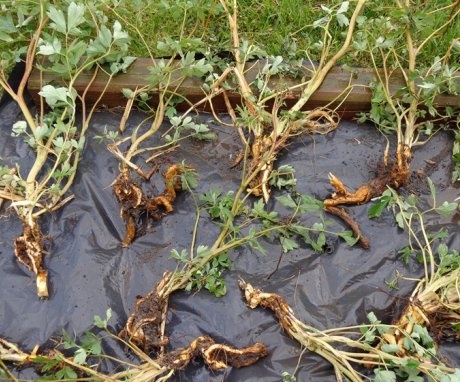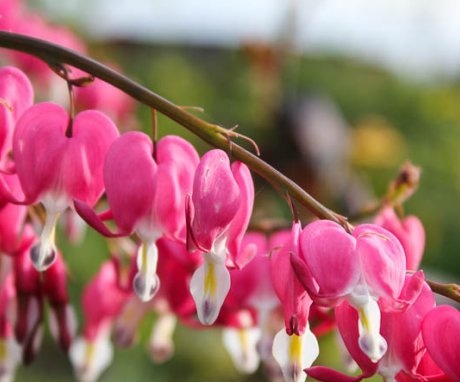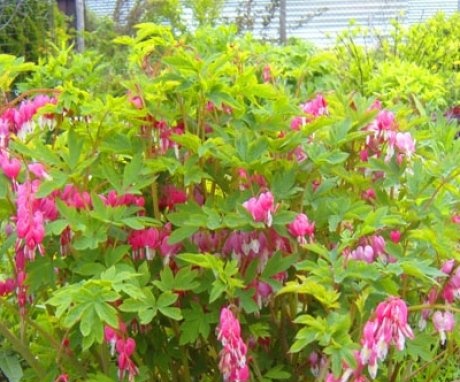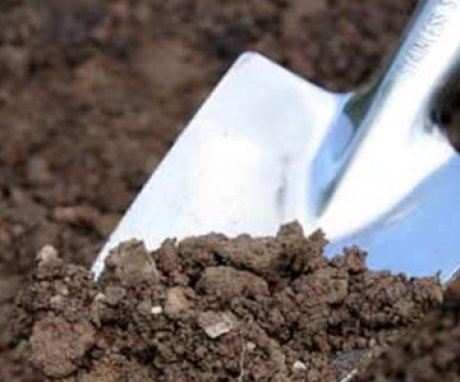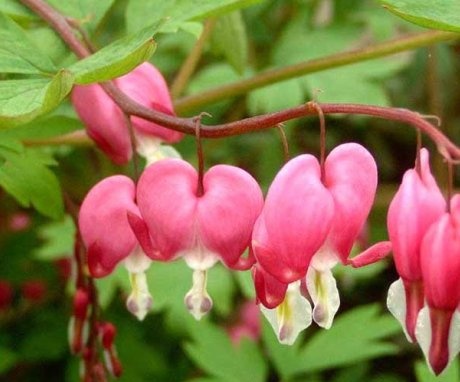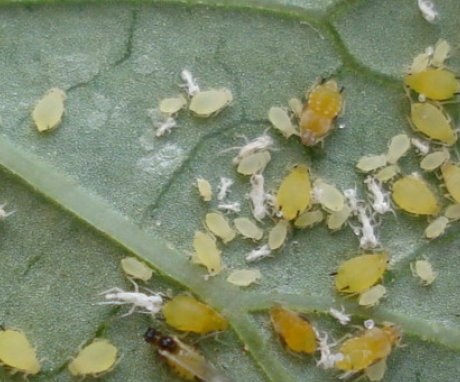Dicentra (broken heart): a charming and unpretentious garden plant
Dicenter - a small decorative flowering plant that is used for landscaping in landscape design. Peerless inflorescences adorn flower beds, borders, entrances to houses or gazebos.
It is not difficult to grow a shrub. However, the plant needs to create certain conditions. About which varieties and species are better suited for a particular region, about the features of reproduction and care, will be discussed in the material.
Content:
- Description of culture
- Types and varieties
- Seed propagation
- Reproduction by dividing the bush
- Cutting decenters
- We create growing conditions
- Soil preparation, terms and rules of planting
- Japanese beauty care
- Diseases and pests
Description of culture
Dicentra native to Japan, also grows in eastern China, North America and the Far East. Some species are found in the wild in the Himalayas. It is grown as a perennial plant, but there are also annuals. Belongs to the Poppy family.
Features of the structure of the dicenter:
- This is a small shrub, reaching a height of 1 m.
- The branches are sinewy, thickened.
- The leaves are pinnately dissected, dark green, gray-gray at the edges.
- Flowers resemble the shape of a heart, they are located on the branches in an arc, drooping.
- There are spurs on the rim.
- The color of the inflorescence is different - white, pink, cream, lavender, depending on the variety and type.
- The fruit is a box with black seeds.
In garden plots, the plant grows up to 5 years without transplanting. Some species reach a height of 1.5 m with flowers up to 3 cm in diameter. The plant is used in landscape design to decorate flower beds, borders, alpine slides, entrances to terraces, gazebos.
They look spectacular in flower beds as a central element, beaten with undersized flowers.
In China and Japan, the nodule dicenter is used for medical purposes, since the juice of this plant species in certain doses is capable of curing some ailments. Only a few types of dicentra are grown - up to 20, in the middle lane there is only one - Broken Heart or Magnificent.
Types and varieties
The type of culture is selected depending on the region. So in the middle lane they give preference to the dicenter of the Magnificent, in the southern regions - to all other species. Allocate:
- Magnificent (also known as "Broken Heart") is a lush shrub that reaches 1 m in height with flowers up to 3 cm in diameter. The most common species among gardeners, unpretentious, develops both in the northern and southern regions. Varieties: "Gold Hut" (pink flowers), "Alba" (white flowers). Withstands frosts down to -35 °.
- Beautiful - a short plant, reaching a height of only 30 cm, flowers 2 cm in diameter, purple. The culture is winter-hardy, but in the northern regions it is closed. Varieties: "Aurora" (white flowers), "King of Hearts" (pink flowers). Alpine slides and curbs are decorated with this view.
- Exceptional - the species reaches 20-25 cm in height, the color of the flowers is different - white, pink, cream. Planted to decorate coniferous plantings, rock gardens and rockeries.
- Vagrant is a low-growing bush, reaching a height of only 20 cm.The flowers are rather large, red, white or pink. Blooms from July to autumn. An excellent option for rock gardens, as the species prefers stony soils.
- Climbing is a thermophilic vine that blooms with yellow, bright flowers. The length of the branches reaches 2 m. Suitable only for cultivation in the southern regions.
- One-flowered is a rare species, it has an unusual shape of petals that bend upwards. As a rule, not grown in the middle lane, very whimsical. Suitable for southern regions only.
- Golden-flowered is a large plant, reaching a height of 1.5 m. Very whimsical, does not tolerate frost. Flowers are yellow, bright. It blooms all season - from spring to autumn.
The dicenter is grown more often, since the bush is quite tall. With its help, beautiful decorative multi-level flower beds are organized. Low-growing plants adorn lawns, conifers, rock gardens and rockeries.
Seed propagation
Dicenter propagates by seeds, dividing the bush and cuttings. The first method is less common due to poor seed germination, and the Magnificent species, for example, does not bear fruit at all. Experienced gardeners resort to the method of "dividing the bush", it is simple and does not require special knowledge and skills.
The seed remains germinating for two years. Seeds are black, shiny. If the florist wants to grow the dicenter with seeds, you will have to be patient. The shrub will begin to bloom only after 2-3 years.
Breeding features:
- Sowing material is sown in autumn, in September, in light, fertile soil.
- A month later, sprouts appear. Fortified seedlings dive and transplanted into pots.
- In the spring, you can plant seedlings in open ground.
If this is a southern region with warm winters, where the air temperature does not drop below 8 °, the seedlings are immediately transplanted into open ground under a film or covering material. Germination temperature - 15 ° -20 °.
Seedling care is standard - watering, airing, picking.
It is better to leave this method of reproduction to experienced plant growers, while in gardening they resort to a simpler, picky method - dividing the bush.
Reproduction by dividing the bush
This method of reproduction is used once every 5-6 years. That is, an adult plant is renewed and propagated at the same time.
Breeding rules:
- In the spring, the bush is carefully dug up. Root system the plants are very fragile. Use a garden trident to dig in and uproot the bush.
- Let the roots dry a little so that they become a little flabby.
- Cut the rhizome into several divisions - the length of the root is about 10 cm, there should be three to four shoots.
- Delenki are transplanted to a permanent place at a distance of 30-40 cm from each other.
In the southern regions, the culture begins to bloom the next year, in the northern - only the second. For the winter, young plants must be covered with a thick layer of mulch.
Cutting decenters
Cuttings are a simple propagation method that gardeners often resort to to propagate bicentra:
- Cuttings are taken in early spring or summer, depending on the type of dicentra:
- A part of the stem with a heel of 10-15 cm is cut off and rooted in light, fertile soil.
- Before planting the cutting, dip it in Kornevin or another means to stimulate root growth.
- The container with the seedling is covered with foil and left in a warm room, the air temperature is 18 ° -20 °.
- Within a month, the root system should develop.
- Cuttings are planted in open ground only the next year.
Caring for seedlings is no different from caring for other crops - watering and periodic airing until the film is removed from the container.
We create growing conditions
The culture is quite unpretentious, with the exception of certain species. She loves sunny places with light shading. The soil is fertile and light.
In flower beds, which are constantly illuminated by the sun, the dycenter will bloom quickly, but it will fade just as rapidly. In the shade, inflorescences gain strength gradually, bloom for a long time. The colors are bright and juicy. Therefore, gardeners choose a bright area with shading.
The plant is not demanding on the soil - it should be light and enriched with organic matter, mineral fertilizers.
Heavy soil is diluted with coarse sand or peat. The ground is damp but not damp. The center does not tolerate waterlogging. It treats feeding well. Often, the culture is planted along the curbs or flower beds are arranged for it. The dicentra will grow in almost any part of the garden, the main thing is to give it a bright place, humid and slightly shaded.
Soil preparation, terms and rules of planting
Planting dates will depend on the region where the shrub is planned to be grown. In the northern regions, the dicenter is planted in spring or early June. In the south - in September. The fact is that the culture tolerates winters well in the South, but in Siberia or the Urals, it will simply freeze out when planted in the fall, no matter how it is covered. Therefore, it is better to plant in the spring.
A shrub site is prepared in advance, in autumn or spring:
- The earth is dug to a depth of 40-50 cm, 3 kg are added per 1 m2 of humus and a complex mineral fertilizer... The dug and enriched soil is left until spring.
- In time, the seedling is planted in holes measuring 30x40 cm at a distance of 30 cm from each other.
- When planting, the soil should be moist and warm. Do not forget that clay soils are diluted with sand or peat.
- Drainage is a prerequisite for growing a dicenter. At the bottom of the holes, you can lay a layer of broken brick or expanded clay, if you are not sure that the earth is good for moisture and air.
After planting, the crop must be cared for, especially in the first year of development. Follow the appearance diseases or pests.
Japanese beauty care
Since the dicentra loves moisture and air permeable soil, the soil around the plant is constantly loosened so that a crust does not form. When loosening, be careful not to damage the top roots of the crop.
To retain moisture, a layer of mulch made of humus or mowed grass 5-7 cm thick is laid. Watering is carried out as the top layer of the earth dries up. You can not overmoisten the bush, arrange dampness. Otherwise, the root system will start to rot. Remove dry flowers and branches. This way the flowering is prolonged.
Weeding is a mandatory step in caring for the dicenter.
During the entire growing season, the plant is fed with nitrogen and phosphorus-potassium fertilizers. Before flowering, superphosphate is added, after - phosphorus-potassium complexes. In total, they feed from 3 to 5 times during the season until August.
In the fall, the bush is cut, leaving about 5 cm of the height of the stems. Cover with a thick layer mulch and spruce branches - 15-20 cm. If the region is not very cold, the layer height may be less, spruce branches are not needed. Dicentra Magnificent can withstand frosts down to -35 °. Proper care is the key to an abundantly flowering shrub, and touching hearts will delight you with juicy, bright colors.
Diseases and pests
The dicenter is very rarely affected by diseases or attacks by pests. Nevertheless, there are several ailments and parasites that can pretty much spoil the appearance of the shrub or ruin it altogether.
The most common and dangerous diseases are distinguished:
- Ring spot
- Microplasma disease
- Root rot
- Stem rot
The most unpleasant and frequent guests are ring spot viruses and microplasma disease. The first ailment can be recognized by spots and stripes on the greenery in the form of oak leaves or rings. Microplasma disease manifests itself in the form of greening of flowers, later the leaves brighten, change shape, the culture ceases to form inflorescences and often dies. It is impossible to cure the dicenter in these cases. But viruses can be prevented.The soil must be treated with formalin one month before planting.
Disinfection is the only salvation from these diseases.
Rot appears due to waterlogged soil, thickened plantings, frequent rains, and sudden changes. Only proper care and planting can save the plant. That is, do not arrange thickets, the culture must be ventilated. Water promptly, in moderation.
More information can be found in the video:
Of the pests, the dicenter is threatened aphids and cicadas. For prophylaxis in the spring, the shrub is treated with insecticides. If parasites appear, spray the plant immediately. It is also worth constantly checking the bush for the appearance of snails or slugs. They are disposed of manually. During the day, when pests sleep, hiding under stones or a layer of mulch, they are easy to spot and remove.
Troubles in the form of diseases or pests are rare, since the plant is resistant to almost all fungal and viral diseases. But do not forget about proper care and tillage of the soil before planting. As a result, the gardener will be able to grow a beautiful, healthy ornamental shrub with inimitable inflorescences in the form of a broken heart!




